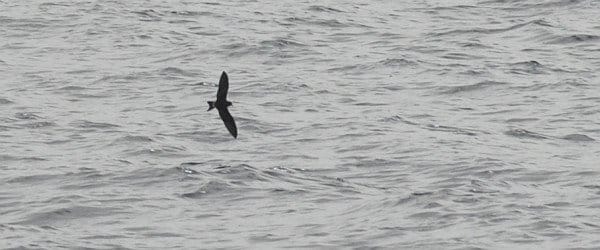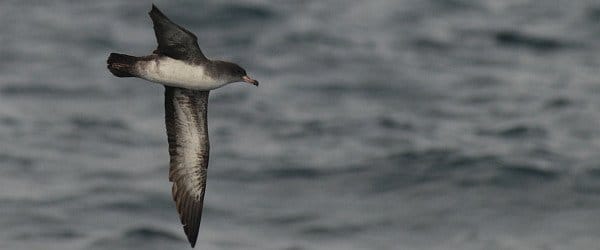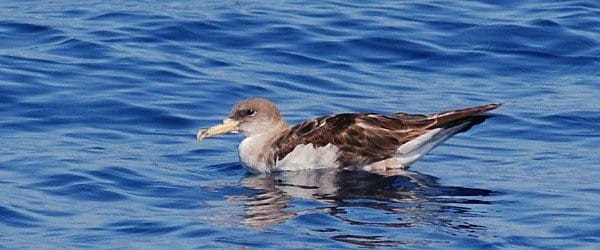Tubenose. No, it’s not part of a Shakespearean insult. Tubenoses are seabirds that belong to an order called Procellariiformes (from a Latin word for storm), and their English name refers to the tube-like structures that cover their nostrils, clearly visible on the Cory’s Shearwater below.
Cory’s Shearwater (Calonectris diomedea) © David J. Ringer
Procellariiformes contains some of the greatest wanderers in the avian world. Some Sooty Shearwaters travel almost 40,000 miles per year in vast, jagged arcs across the Pacific Ocean. And the famous Wandering Albatross has the largest wingspan of any living bird, nearly 12 feet across in the largest individuals.
It may be a surprise, then, to learn that these extremely aerial seabirds appear to be most closely to — Can you guess? — penguins. But genetic and morphological data both point to this conclusion, and additional evidence places tubenoses and penguins within a group recently dubbed Aequornithes, or “higher waterbirds.” The higher waterbird clade is a wonderfully diverse group consisting of loons, penguins, tubenoses, storks, Suliformes, herons and ibises, pelicans, the Shoebill, and the Hamerkop.
Within Procellariformes, the arrangement of major groups of tubenoses is not entirely settled. Four families are often recognized: storm-petrels, albatrosses, shearwaters and petrels, and diving-petrels. But several studies suggest that the storm-petrels actually belong in two different families and that diving-petrels are embedded within the rest of the petrels and shearwaters.
And species-level taxonomy of the tubenoses remains a great frontier for study and discovery. Because most of these birds nest on islands and travel enormous distances across open ocean, their breeding habits are in some cases poorly known. And some groups of species or possible species look so similar that they are virtually impossible to separate in the field, which obscures knowledge of their ranges and breeding behaviors. Much work remains to be done in this realm, but for now, let’s just take a look at the major groups within this fascinating order.
Southern Storm-Petrels
Storm-petrels are very small, songbird-sized tubenoses that feed by pattering their feet on the surface of the water and picking tiny prey from the surface. As their name indicates, southern storm-petrels breed in the Southern Hemisphere (see Duncan’s photos of White-faced Storm-Petrels). Wilson’s Storm-Petrels travels north of the equator during the southern winter; Nate Swick has a great post about them.
Northern Storm-Petrels

Leach’s Storm-Petrel (Oceanodroma leucorhoa) © David J. Ringer
And northern storm-petrels, similar in many respects to their southern cousins, breed, well, farther north, even into northern Europe, Japan, and Canada. It is within this group that the smallest tubenose occurs: The Least Storm-Petrel is similar in size and proportions to a Tree Swallow.
Albatrosses
The enormous albatrosses are, amazingly enough, apparently most closely related to the diminutive storm-petrels. The largest albatrosses can weigh more than a Thanksgiving turkey, with wingspans exceeding 10 and even 11 feet. They are largely, but not entirely, a Southern Hemisphere group (Duncan, once again, brings the goodness from New Zealand, and many are threatened with extinction because of manmade changes to their island strongholds and deadly fishing practices including longlining.
Petrels and Shearwaters (including Diving-Petrels)

Pink-footed Shearwater (Puffinus creatopus) © David J. Ringer
This relatively diverse family includes a number of distinctive groups:
- Fulmarine petrels, including the huge and predatory giant petrels and the more familiar Northern Fulmar;
- Prions, small, almost storm-petrel-like birds that are tough to identify but (I hear) fun to watch;
- Gadfly and procellarine petrels, wide-ranging and highly pelagic species;
- Shearwaters, which are some of the world’s champion fliers but can also dive to depths of 200 feet in pursuit of fish and other prey (don’t miss this spectacular and eerie BBC clip, Shearwater Attack!);
- Diving-petrels, Southern Hemisphere birds, small and football-shaped with small wings, built like Northern Hemisphere alcids.
Do you get far enough from land to see tubenoses? Which are your favorites?
To learn more about the Procellariiformes, I highly recommend Albatrosses, Petrels and Shearwaters of the World by Derek Onley and Paul Scofield.












Great post, David! Some day I will see an albatross. Some day.
Also, one small error to point out. It is “Corey’s” Shearwater. Please make a note of it. 🙂
Why stop there, Corey? Dream bigger and go for “King Corey’s Shearwater.” Has kind of a nice ring.
@David: I like the way you think!
Awesome post! FYI My favorite tubenoses are Kerguelen, Blue, and Zino’s Petrels, Tasmanian Albatross, and Hornby’s Storm-Petrel. I certainly hope to do work with these incredible birds in the future!
Good post. I live in New England where I work on a fishing boat. I love in the early spring when we start seeing the shearwaters arrive. Beautiful birds to watch fly when a strong breeze is blowing. Right now off Block Island we are seeing many adult gannets. Also beauties. Fulmars too. The gannets are following the sea herring. So are the dolphins. It is a great time of year. Like a scene from the series Blue PLanet.
The first bird I ever became enamored by was a greater shearwater.
Thanks for sharing your thoughts. I always enjoy reading about pelagics.
John.
For shame. If you’re going to lump the Diving-petrels in with the rest of the procellariids, at least divide the procellariids up correctly. Bulweria and Procellarine petrels with the prions, Pseudobulweria and Lugensa with the shearwaters.
Gadfly petrels and procellarines indeed.
Hey Duncan, what do you think of Boyd’s synthesis? http://jboyd.net/Taxo/List7.html#procellariidae
It isn’t ridiculously disimilar from the one we use on Wikipedia. I notice he’s got the Pterodroma (or true gadlfies) as his basal group. I’d like to know his source for referring to the Kerguelen Petrel as Aphrodroma as opposed to Lugensa. Interesting that he hasn’t got the diving -petrels in with the rest of the Procellariids.